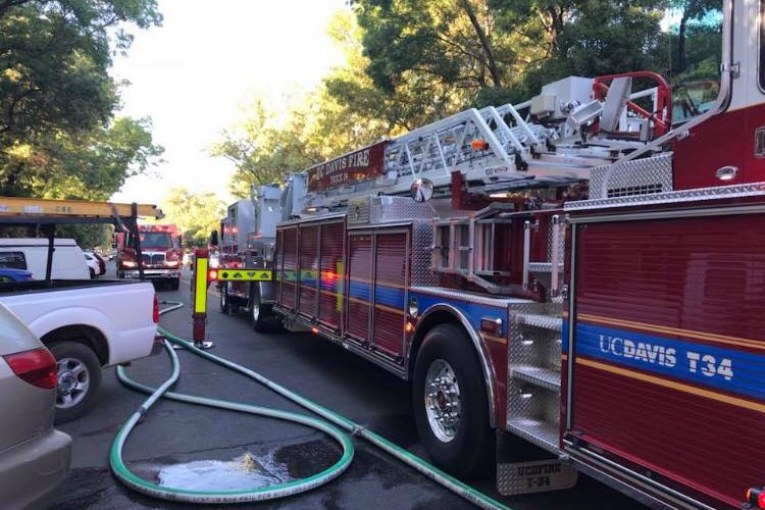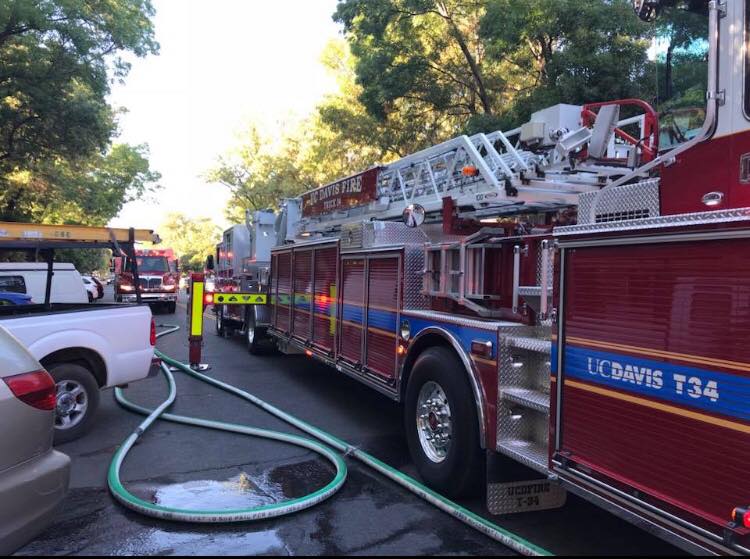

By David M. Greenwald
The idea was first discussed last fall, with an increasing number of three- and four-story buildings, about the purchase of its own ladder truck. But the estimated costs include about $2.1 million in ongoing costs plus another $645 thousand to $1.26 million in ongoing staffing costs, depending on whether the city hires 3 or 6 firefighters as the result of this purchase.
This week the Finance and Budget Commission discussed the potential acquisition of a ladder truck in order “to determine whether there was sufficient information for the city council to decide whether to approve this purchase.”
The commission concluded “they, and subsequently the City Council, would benefit from additional information prior to making a decision.”
In addition, “the Commission recommended that, should the City proceed with the acquisition of a ladder truck, staff develop a procurement strategy designed to ensure the lowest cost that meets the public safety need and other city needs. This will likely be one of the largest procurements ($2 million estimate) of a good that the City will make, so it deserves extra attention.”
There have been a number of discussions previously on the need for the ladder truck. In November, Chief Joe Tenney presented that “there are currently over 200 three-story buildings in Davis and multiple current projects of 4-7 story buildings approved or under construction.”
He further argued that the availability of fire department resources “has been challenged throughout California for the last several years, including in Yolo County and the immediate area.”
“As part of the justification to the need, it is very important to understand that this specialized apparatus operational focus is not just about the 100’ aerial ladder that provides access to buildings up to seven stories,” Tenney writes in the staff report. “On every structure fire, regardless of the size or height of the building involved, the ladder truck company is assigned specific tasks in alignment with their purpose, such as ventilation, search and rescue, utilities control, forcible entry for access, overhaul and salvage. The ladder truck would have emergency responses and daily duties that help the Fire Department accomplish its goals and objectives in serving the community.”
He adds, “The associated costs above address many aspects of this increase in public safety.”
Tenney cites one-time purchasing costs, annual operations and maintenance, replacement cost and the funds needed to staff the ladder truck.
Additionally, he writes, “we will be including the need to remodel Fire Station 31 and the operational plan for training personnel on the new apparatus.”
In the Fitch and Associates Standards of Cover report, they found “it is recommended that the City of Davis invest in their own ladder truck.” It further said “that doing so would improve coverage, redundancy, critical tasks for structure fires and technical rescues. The report determined the best location would be Station 31.”
Lastly, the report said, “A community the size of the city of Davis with the complexity of risk should not be without consistent ladder truck service or depend on an apparatus from distant communities when the UC Davis apparatus is unavailable.”
A subcommittee of Gurkern Sufi and Paul Jacobs concluded, “We both recognize the great service provided by our local firefighters and do not take this for granted.
“And we recognize that in this time of state-wide fire emergencies the DFD is often ‘stretched thin.’ We also appreciate the effort to secure grants wherever possible to improve service and reduce risk in our community.”
But they write, “[W]e also believe that every new commitment of City funds should be thoroughly reviewed before being adopted. And we recognize, that in the end, it is up to the Council to set priorities for how taxpayer dollars are expended. In that spirit, we offer these questions and comments.”
Among their key questions, they ask: How many 3-story vs. 4-story buildings does Davis now have? They note, “The November report to council says more than 200. It notes, for example, there have been a number of fires at the University Retirement Community, which includes four-story structures.”
Another key question: “How often have ladder trucks from UC Davis and other jurisdictions been called on.”
Meanwhile, a subcommittee comprised of Doug Buzbee, Ezra Beeman, and Donna Neville asked, “Is there a need?”
They write,”At the bottom of page 1 of Chief Tenney’s staff report, he asserts that it has been established that there is a critical need for a ladder truck for the City of Davis. Was there some third party professional report that establishes this? Is there an NFPA standard that the City does not meet? Is there communication from some other authority that supports this statement?
“It is not clear to me that there is a critical need for a new ladder truck. I would request that that be established in some formal way, rather than the Chief simply saying ‘we need a ladder truck.’”
They also point out, like the other subcommittee, “The City cannot make this decision on the benefits of a new ladder truck without considering alternative ways of meeting this need. We need to know how many times the City has needed to make use of the UCD ladder truck over the past few years.”
They add, “Nothing in the staff analysis indicates whether a joint use agreement has been considered and we believe this should be explored.”
They also note, “The ongoing cost of staffing the truck is the most problematic to us. This adds significant additional staffing costs, dedicated only to this truck, which may only be used occasionally. Further adding these staff positions will add to the city’s OPEB/Pension costs.”
The group concludes: “In the absence of justification for the one-time and ongoing costs, I think there are higher priorities.”
—David M. Greenwald reporting
Support our work – to become a sustaining at $5 – $10- $25 per month hit the link:







why would it be unavailable? Because of a fire on campus in a high-rise? How often would that happen?
No stats available on how many times the UC ladder track was called on before the meeting? This stinks of a money grab. I think ladder-truck manufacturers are behind this. No actually I think it’s the union.
I am less than unconvinced.
The lack of data on need versus cost is concerning here.
But think how awesome it would look sitting outside of Nugget.
Suddenly DG is a fiscal conservative. Welcome!